Master children’s clothing sizes with expert tips, size charts, and brand comparisons for the perfect fit every time
Table of Contents
- Understanding Kids Clothing Size Basics
- How to Measure Your Child Correctly
- Size Charts and Conversions Explained
- Brand-Specific Sizing Intelligence
- Common Sizing Mistakes to Avoid
- Sizing by Clothing Type
- International Size Conversions
- Modern Sizing Tools and Apps
- Expert Shopping Strategies
- Frequently Asked Questions
Understanding Kids Clothing Size Basics
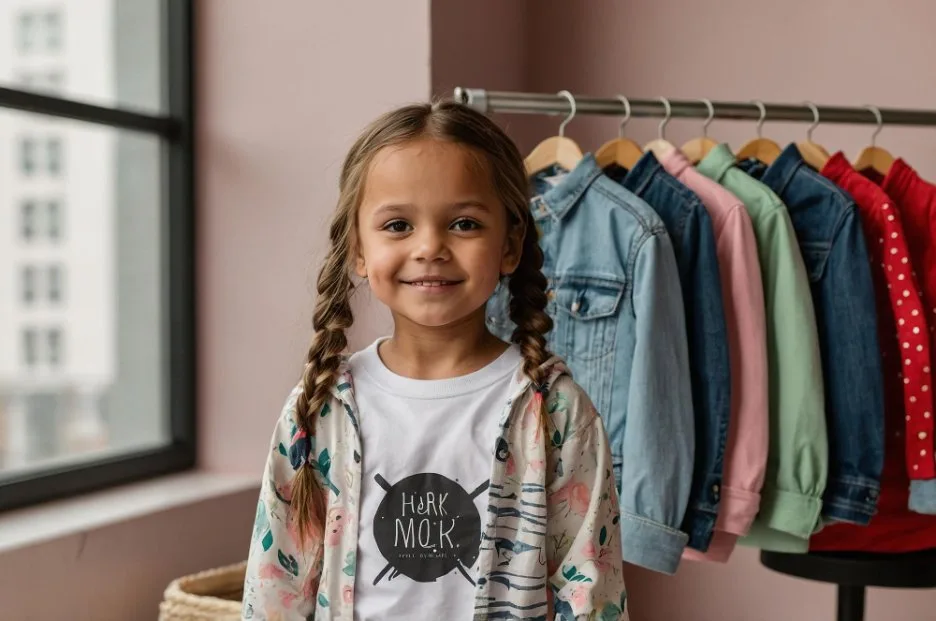
Shopping for kids’ clothes can feel like solving a puzzle, especially when every brand seems to size things differently. Even if the tag says a certain size or age, it often doesn’t tell the whole story about how the clothing will actually fit. Kids’ clothing sizes are primarily based on age, weight, and height, but using size charts and measuring your child gives you the best fit.
Key Insight: Research shows that pediatricians use standardized growth charts to track children’s development, and the same principles apply to clothing fit. Children grow at different rates, making individual measurements more reliable than age alone.
How Kids Sizing Differs From Adult Clothing
Kids’ sizing systems don’t use small, medium, or large like adult clothes. Instead, most brands use age or size numbers, like 2T, 4, 6X, or 10. The “T” in sizes stands for “toddler” and usually ranges from 2T to 5T.
Unlike adults, kids’ sizes are linked mostly to age, but this can lead to confusion. For example, a size 6 is meant for average 6-year-olds, but not every child the same age will fit that size. Older kids move to “big kids” sizes, listed as numbers from 7 to 16. These numbers don’t match adult sizes and vary from brand to brand.
Baby Sizes
Preemie – 24M
Based on weight & height
Toddler Sizes
2T – 5T
T = Toddler cut
Little Kid
4 – 6X
Transition sizing
Big Kid
7 – 16
More adult-like proportions
Do Kid Sizes Go by Age?
While many parents assume kids’ sizes directly correspond to age, this isn’t always accurate. Size labels use age as a starting point, but children’s growth patterns vary significantly. A 4-year-old might fit into size 3T, 4T, or even 5T depending on their individual measurements.
How to Measure Your Child Correctly
Getting accurate measurements is the foundation of finding the right fit. Since durable clothes for toddlers need to fit properly to last through active play, proper measuring is essential.
Essential Measurements You Need
Height Measurement
Have your child stand straight against a wall without shoes. Make sure their feet are flat and together, and their back is straight. Use a flat object like a book to rest lightly on top of their head and mark the spot on the wall. Measure from the floor to the mark with a tape measure.
Chest Measurement
Wrap a soft measuring tape around the fullest part of the chest, usually just under the armpits and across the shoulder blades. The tape should go straight across the back and front, not too tight or loose.
Waist Measurement
Find the narrowest part of the torso and wrap the tape around it. Have your child stand relaxed, not sucking in. Keep the tape snug but not squeezing.
Hip Measurement
Measure around the widest part of the hips and bottom. Make sure the tape stays horizontal and doesn’t dip in the back.
Common Measuring Mistakes to Avoid
- Using the wrong measuring tape: Use a flexible, soft tape measure, not a rigid ruler
- Measuring over thick clothing: Take measurements over light clothing or undergarments
- Not accounting for growth: If your child is between sizes, choose the larger one
- Forgetting to remeasure: Update measurements every 3-4 months during growth spurts
Size Charts and Conversions Explained
US Sizes for Kids
US children’s sizing follows this general pattern:
| Size | Age Range | Height (inches) | Weight (lbs) | What to Know |
|---|---|---|---|---|
| 2T | 2-3 years | 33-36 | 26-29 | Roomier diaper area |
| 4 | 4-5 years | 39-41 | 34-39 | Slimmer fit than 4T |
| 6X | 6 years | 46-47 | 52-58 | Bridge size to 7 |
| 7 | 7 years | 48-50 | 57-63 | Start of “big kid” sizes |
| 10-12 | 10-12 years | 54-58 | 75-95 | Often considered Medium |
UK Sizes for Kids
UK sizing is similar to US but with some differences in labeling and fit. UK sizes typically run slightly smaller than US equivalents.
What Does 6M Mean – 3,6 or 6,9?
Important clarification: When you see “6M” on baby clothes, it typically means the item fits babies around 6 months old (usually 6-9 months range). However, “6-9M” specifically indicates the size fits babies from 6 to 9 months old. Always check the specific brand’s size chart, as some use “6M” to mean 3-6 months instead.
Size Comparison Quick Reference
Letter Sizes in Kids Clothing
| Size | Age Range | Number Equivalent | Notes |
|---|---|---|---|
| XS | 4-5 years | 4 | Extra Small |
| S | 6-7 years | 6 | Small |
| M | 8-10 years | 8-10 | Medium |
| L | 10-12 years | 10-12 | Large |
| XL | 12-14 years | 14-16 | Extra Large |
What Age Wears Size 10? Size 12?
Size 10 typically fits children aged 9-10 years, while size 12 usually fits 11-12 year olds. However, these are guidelines only. Some 8-year-olds wear size 10, and some 10-year-olds wear size 12, depending on their growth pattern.
Is size 12 a small or medium? In kids’ clothing, size 12 is generally considered a Large (L) in letter sizing, while sizes 8-10 are typically Medium (M).
Brand-Specific Sizing Intelligence
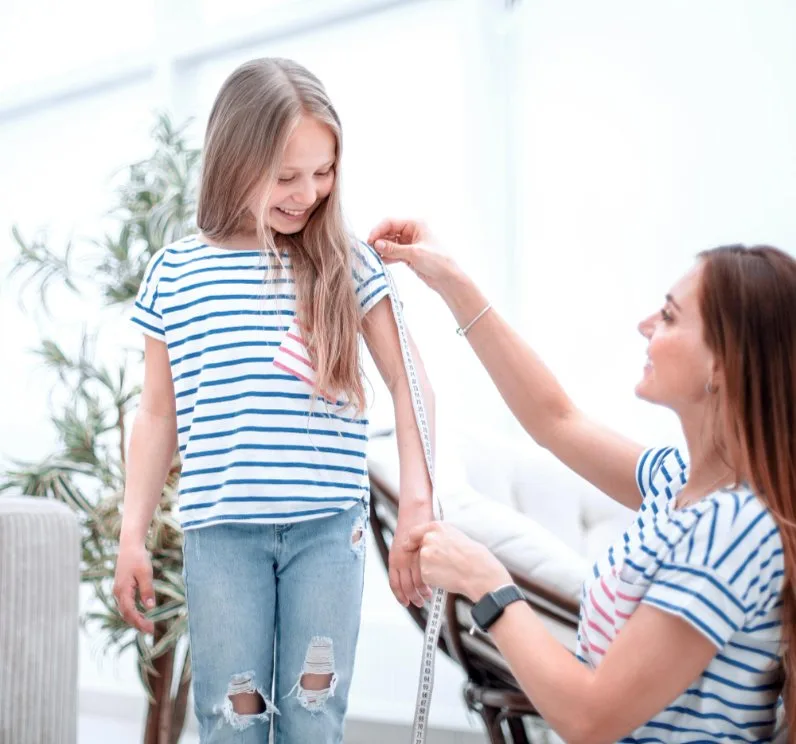
One of the biggest challenges parents face is that sizing varies significantly between brands. Research shows that 48% of parents cite quality as the most important factor when buying kids’ clothes, but inconsistent sizing affects purchasing decisions.
Carter’s
Sizing: Runs true to size
Best for: Infants and toddlers
Note: Uses weight/height measurements prominently
Gap Kids
Sizing: Runs slightly large
Best for: All ages
Note: Consistent across seasons
Old Navy
Sizing: Runs large
Best for: Budget-conscious families
Note: Size down for better fit
Nike Kids
Sizing: Runs small in tops, true in bottoms
Best for: Athletic wear
Note: Size up for layering
How Do Different Brands Run?
| Brand | Sizing Tendency | Recommendation | Best Age Range |
|---|---|---|---|
| H&M Kids | Runs small | Size up | 2-12 years |
| Target (Cat & Jack) | True to size | Follow size chart | All ages |
| Children’s Place | Runs large | Size down or use measurements | Toddler-teen |
| Gymboree | Runs very large | Size down 1-2 sizes | Baby-12 years |
Common Sizing Mistakes to Avoid
Even experienced parents make sizing errors. Here are the most common mistakes and how to avoid them:
The Top 10 Sizing Mistakes Parents Make
- Relying only on age labels – Always check measurements
- Forgetting about shrinkage – Account for cotton items shrinking 5-10%
- Not considering growth spurts – Buy slightly larger during rapid growth phases
- Ignoring brand differences – Each brand has unique sizing
- Shopping too far in advance – Kids’ growth is unpredictable beyond 6 months
- Not checking return policies – Essential for online purchases
- Buying exact fit – Leave room for comfort and growth
- Overlooking fabric stretch – Stretchy fabrics are more forgiving
- Not involving the child – Older kids have fit preferences
- Panic buying before growth spurts – Keep some larger sizes on hand
What to Do When Your Child is Between Sizes
Decision Framework:
- For everyday clothes: Choose the larger size
- For special occasion wear: Choose the size that fits now
- For winter coats: Always size up for layering
- For shoes: Choose larger with growing room
- For fitted items (like tights): Choose the smaller size
Emergency Last-Minute Shopping Tips
When you need clothes immediately and can’t measure:
- Bring a well-fitting item from home for comparison
- Choose stores with generous return policies
- Buy from brands you know well
- Opt for adjustable features (elastic waistbands, drawstrings)
- When in doubt, buy two sizes and return one
Sizing by Clothing Type
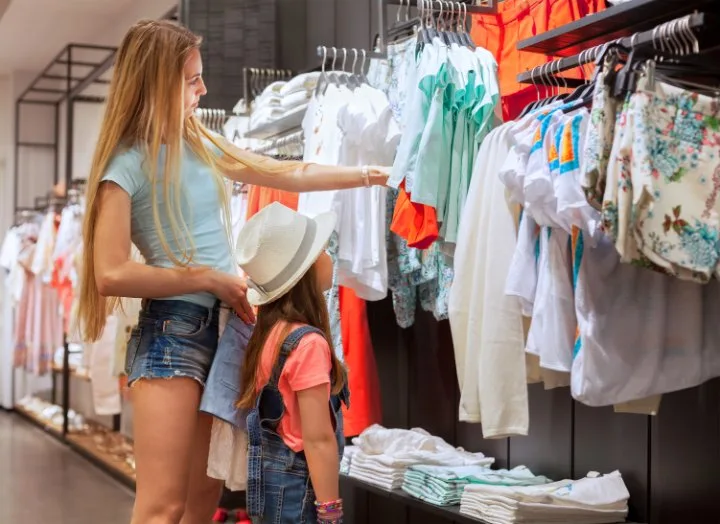
Shirts and Tops Sizing
Shirts and tops usually focus on chest measurement and sometimes torso length. For the best fit, measure across the fullest part of your child’s chest and check the length from shoulder to waist.
Short sleeve, long sleeve, and tank tops may have slightly different fits. Short sleeve shirts might run looser, while tank tops could be snug. Button-up shirts tend to add extra room for layering.
Pants and Bottoms Sizing
Pants rely heavily on waist and inseam measurements. Unlike tops, pants often come with more adjustability, like elastic or drawstring waists. Many parents ask about potty training pants which typically need a looser fit for easy removal.
Outerwear and Coats Size Guide
Coats and outerwear need room for layers, so sizing is slightly more generous. Make sure to consider not just chest size, but also arm length and shoulder width. For winter gear, there should be space for a sweater underneath without making the coat look baggy.
Footwear Sizing
Shoe sizing deserves special attention. Comfortable daily footwear for toddlers should have about a thumb’s width of space at the toe. Children’s feet grow quickly, often requiring new shoes every 4-6 months.
| US Shoe Size | Approximate Age | Foot Length (inches) | Notes |
|---|---|---|---|
| 5 | 12-18 months | 4.75 | First walking shoes |
| 6 | 18-24 months | 5.13 | Confident walker |
| 7 | 2 years | 5.38 | Running and climbing |
| 8 | 3 years | 5.63 | More structured activities |
International Size Conversions
Shopping from International Brands
When buying clothes from international retailers or traveling abroad, different countries use different sizing systems. European sizes use height in centimeters rather than age, while Asian brands often run smaller than Western equivalents.
How US and UK Sizes Work
US and UK sizes are both typically age-based, but UK sizes often run smaller than US equivalents. A UK size 5-6 years might fit like a US size 4-5 years.
European Sizing System
European sizes use height in centimeters rather than age. This system can be more accurate since it’s based on actual measurements rather than assumptions about age-related size.
Interactive Size Conversion Calculator
International Size Conversion
Shopping from international brands? Use our international kids size converter to instantly translate sizes between US, UK, European, Australian, and Asian systems. This tool helps ensure the perfect fit when ordering from global retailers.
| Age | US Size | UK Size | EU Size (Height cm) | Height Range |
|---|---|---|---|---|
| 2-3 years | 2T | 2-3 | 92-98 | 33-38 inches |
| 4-5 years | 4-5 | 4-5 | 104-110 | 40-43 inches |
| 6-7 years | 6-7 | 6-7 | 116-122 | 45-48 inches |
| 8-9 years | 8-9 | 8-9 | 128-134 | 50-53 inches |
| 10-11 years | 10-11 | 10-11 | 140-146 | 55-57 inches |
What is UK Junior Size 1?
UK Junior size 1 typically corresponds to US size 7-8 and fits children aged 6-7 years. It’s part of the “junior” sizing that bridges between little kid and big kid sizes.
Understanding European Height-Based Sizing
European Size Examples:
- Size 86: 18-24 months (height 30-34 inches)
- Size 104: 4-5 years (height 40-43 inches)
- Size 128: 8-9 years (height 50-53 inches)
- Size 152: 12-13 years (height 59-62 inches)
Modern Sizing Tools and Apps
Technology is revolutionizing how we shop for kids’ clothes. Several apps and tools can help you find the right size more accurately than traditional methods.
Best Sizing Apps for Parents
SizeCast
What it does: Predicts future clothing sizes based on growth charts
Best for: Buying ahead for seasonal sales
Covers: 80+ popular brands
AlvaKids
What it does: Size recommendations across hundreds of brands
Best for: Cross-brand shopping
Features: Growth predictions, brand comparisons
True Fit
What it does: Uses your fit preferences to recommend sizes
Best for: Online shopping confidence
Available at: Major retailers like Nordstrom
Store-Specific Technology
Many retailers now offer their own sizing tools:
- Nike: Size recommendation tool using age and height
- Target: Size finder with detailed measurements
- Amazon: Customer review insights on fit
- Zappos: Detailed shoe fit information and reviews
Expert Shopping Strategies
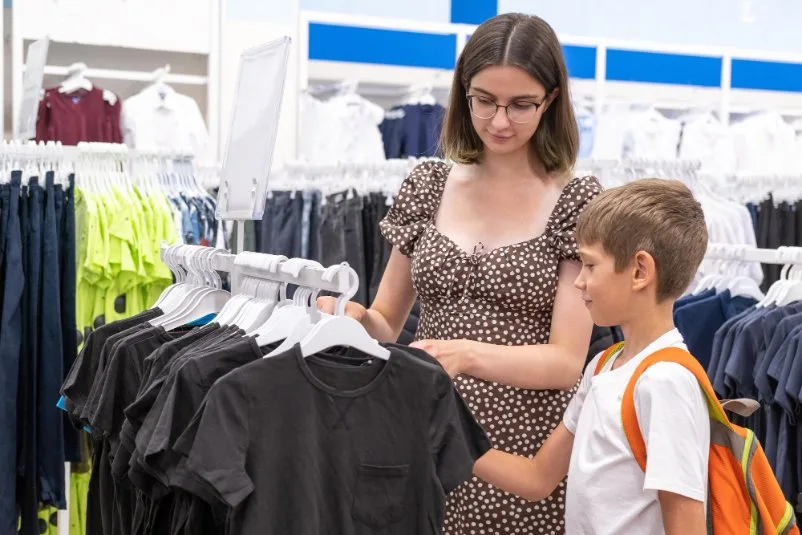
Seasonal Shopping Strategy
Smart parents shop strategically across seasons to save money and ensure proper fit:
Best Times to Shop by Season
- End of Summer: Buy fall clothes in current size
- End of Fall: Buy winter coats one size up
- January: Buy spring clothes in next size up
- End of Spring: Buy summer clothes in current or next size
Growth Tracking and Size Planning
Smart parents track their child’s growth patterns to anticipate sizing needs. Our kids size prediction calculator helps you forecast future clothing sizes based on growth patterns, allowing you to plan purchases and shop sales confidently.
For school shopping, follow this timeline:
- July: Take fresh measurements
- Early August: Shop for immediate needs in current size
- Late August: Buy a few items one size up for mid-year growth
- Throughout year: Monitor for growth spurts
Holiday Gift Sizing Tips
When buying clothes as gifts (especially for relatives):
- Ask for recent measurements, not just age
- Choose gift cards when unsure
- Buy for the next season in a larger size
- Include gift receipts for easy exchanges
- Consider quality items that can be passed down
Budget-Conscious Sizing Strategy
For budget-friendly shopping while maintaining good fit:
- Focus spending on quality basics from reputable brands
- Buy adjustable items (elastic waists, roll-up sleeves)
- Shop end-of-season sales for next year
- Consider consignment for special occasion wear
- Trade with other families in your community
Can Kids Sizes Fit Adults?
Some adults, particularly petite women, can wear kids’ sizes. Generally:
- Kids’ XL (14-16): May fit adult XS-S
- Youth XL: Often cheaper than adult sizes
- Consider proportions: Kids’ clothes have different arm/torso ratios
- Best for: Basic t-shirts, hoodies, some activewear
Frequently Asked Questions
A typical 10-year-old wears size 10-12 in kids’ clothing, which corresponds to Medium (M) in letter sizing. However, this varies significantly based on the child’s height and build. Some 10-year-olds wear size 8, others wear size 14. Always measure your child for the most accurate fit.
Kids size 10-12 is typically considered Medium (M) in letter sizing. However, this can vary by brand. Some brands consider size 12 as Large (L), while others group 10-12 as Medium. Always check the specific brand’s size chart.
Children typically wear size 10 around age 9-10 years old. However, some 8-year-olds who are tall for their age may wear size 10, while some 11-year-olds who are smaller may still fit size 10. Height and build matter more than age.
Size 4 typically fits children aged 4-5 years old. This is different from 4T, which fits 3-4 year olds. Size 4 has a slimmer fit than 4T and assumes the child is potty trained (no diaper room). Some tall 3-year-olds or small 6-year-olds might also wear size 4.
An 11-12 year old typically wears size 12-14 in kids’ clothing, which often corresponds to Large (L) or Extra Large (XL) in letter sizing. At this age, some children may start transitioning to adult sizes, particularly in shoes and outerwear.
Kids’ and youth sizes overlap but aren’t identical. “Kids” usually refers to ages 4-12 (sizes 4-12), while “youth” often covers ages 6-16 (sizes XS-XL). Youth sizes tend to have more mature proportions and styling compared to kids’ sizes.
Youth XL typically fits children aged 12-14 years with measurements around:
- Height: 58-62 inches
- Chest: 32-34 inches
- Weight: 90-110 lbs
This size often corresponds to adult XS in length but with smaller proportions in the waist and chest.
A 10-year-old typically wears a size Medium (M) or size 10-12 t-shirt. However, preferences vary – some kids like a looser fit (size Large), while others prefer fitted styles (size Small). Consider your child’s build and style preferences when choosing.
Yes, kids’ sizes typically start at 4 and go up to 6X or 7, depending on the brand. Size 7 marks the beginning of “big kid” sizes, which then continue through size 16. Some brands skip 7 and go directly from 6X to 8.
To determine between size 10 or 12, measure your child’s height, chest, and weight, then compare to the brand’s size chart. If measurements fall between sizes, consider:
- Choose size 12 for growing room
- Choose size 10 for a fitted look
- Consider the garment type (fitted vs. loose styles)
- Factor in recent growth spurts
Special Considerations
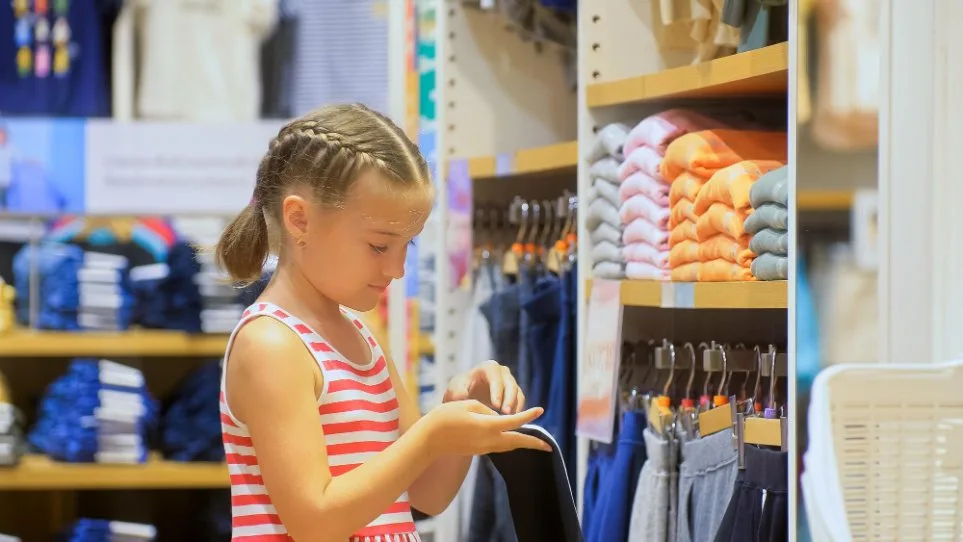
Adaptive Clothing and Special Needs
Children with special needs may require adaptive clothing with features like:
- Magnetic closures instead of buttons
- Side-opening pants for seated children
- Sensory-friendly fabrics for children with autism
- Easy-access designs for medical devices
When shopping for adaptive clothing, focus on comfort and functionality over standard sizing rules. Many brands now offer specialized lines for children with different needs.
Athletic and Active Kids
Very active children or those involved in sports may need different sizing considerations:
- Athletic build: May need larger sizes for broader shoulders
- Sports uniforms: Often run smaller, size up
- Active play clothes: Choose stretchy, durable fabrics
- Growth spurts: Athletes may experience rapid growth
Seasonal Sizing Adjustments
Consider seasonal factors when choosing sizes:
- Winter clothing: Size up for layering
- Summer swimwear: Often runs small, check carefully
- Rain gear: Should fit over regular clothes
- Holiday outfits: Buy for current size if event is soon
Conclusion
Understanding kids’ clothing sizes doesn’t have to be overwhelming. While the sizing landscape can seem confusing with different brands, international variations, and rapidly growing children, following the right strategies makes shopping much easier and more successful.
Key Takeaways for Perfect Fit Every Time
Essential Recommendations:
- Measure regularly: Take fresh measurements every 3-4 months, especially during growth spurts
- Use measurements over age: Height, weight, and chest measurements are more reliable than age-based sizing
- Know your brands: Stick to 2-3 favorite brands whose sizing you understand
- Plan for growth: When in doubt, size up rather than down for everyday clothing
- Embrace technology: Use sizing apps and brand-specific tools to make better decisions
Long-term Sizing Strategy
Develop a systematic approach to sizing that grows with your family:
- Create a sizing profile: Keep track of your child’s measurements and what sizes work in different brands
- Budget strategically: Invest in quality basics that last through growth spurts, buy trendy items in current size
- Shop seasonally: Buy ahead during sales, but not more than one season in advance
- Build relationships: Connect with other parents for hand-me-down exchanges and sizing advice
- Stay flexible: Children’s growth patterns change, so adjust your approach as needed
The Future of Kids’ Sizing
The children’s clothing industry is evolving toward more accurate and inclusive sizing. Trends include:
- Technology-based fit solutions and virtual try-ons
- More inclusive sizing for different body types
- Sustainable approaches to sizing that accommodate growth
- Better standardization across brands
Final Advice
Remember that finding the right fit is a skill that improves with practice. Don’t get discouraged by sizing mistakes – they’re part of the learning process. Focus on comfort, quality, and functionality over perfect fit, especially for rapidly growing children.
Most importantly, involve your child in the process as they get older. Their comfort and confidence in their clothing affects how they feel about themselves. A well-fitting wardrobe supports not just physical comfort but also helps children develop their personal style and self-confidence.
For more helpful guides on children’s clothing, explore our articles on essential toddler clothing and caring for different fabric types to keep those well-fitting clothes looking great longer. Don’t forget to bookmark our size prediction calculator to plan ahead for your child’s growth spurts.

